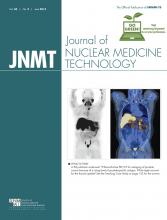REPLY: I would like to thank Dr. Currie for his interest in my recent JNMT article (1). He is correct in pointing out that the article has a “northern hemisphere” perspective, which in reality reflects the major sources of supply and demand for 99Mo. He also correctly points out the fact that the OPAL (Open Pool Australian Lightwater) reactor supplies a not-insignificant source of approximately 8% of the world demand for 99Mo, some of which is shipped to the northern hemisphere. There was no intention of negating the role of the many regional reactors; rather, the intention of the article was to highlight the nonreactor alternatives under development, which are designed to help wean the world off our current paradigm of reactor-sourced, and thus government-subsidized, isotope production.
As I stated in my article, “The existing infrastructure of large reactors will be upgraded to increase their production capacity, which should cover the short-term concerns.” Although not explicitly stated, the Australian Nuclear Science and Technology Organisation (ANSTO)–OPAL reactor was inferred in this statement, especially since there are plans for upgrading this reactor with a goal of meeting about 30% of the world demand with perhaps future increases.
All will agree that the cessation of the 99Mo production at the NRU (National Research Universal) Reactor (or any of the current suppliers) in 2016 represents a major concern and will lead to supply shortages (2). These risks will remain as long as the world maintains a centralized production model in, and an aging infrastructure for, a short-lived radioactive product. The supply of 99Mo is, and will continue to be, fragile. The search for alternatives to 99Mo/99mTc has been a priority, and this article was aimed at showing that even several efforts (including reactors) are potential solutions on a regional, national, and perhaps international level.
I would like to emphasize that there have been several recent developments in “nonneutron” production methods of both 99Mo and 99mTc as highlighted in the original article. In addition to the activities at MURR (Missouri University Research Reactor), contracts between NorthStar and SHINE Medical Technologies with large-scale private-sector partners provides for avenues to decentralize supply, at least in North America. Also, significant developments in Canada toward direct-cyclotron production of 99mTc add to the mix of options. The two Canadian groups have demonstrated multicurie production of 99mTc, sufficient to supply urban centers on a daily basis (>1.10 TBq, 30 Ci/irradiation) (3). Such solutions enable a decentralized production model with the potential of maintaining interregional redundancy to help stave off future widespread supply shortages. Those wanting to be in control of the reliability of their own supply will have options.
In closing, it is my hope that readers will come away from these articles and opinion pieces with the impression that there remains a significant risk in the existing 99mTc supply chain, and concern about the viability of an aging global reactor infrastructure should be taken seriously. With the development of several alternative production methods from many sources (neutron-, proton-, and electron-based methods included), there is optimism that a full-cost-recovery solution exists and that the future of isotope production will be dictated by a free market, unperturbed by subsidy.
Footnotes
-
Published online Apr. 9, 2015.







